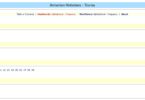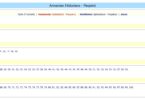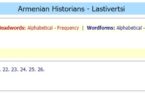Sts. Sahak and Mesrop Medal Acceptance Speech Thomas J. Samuelian
August 30, 2006 Etchmiadzin
Thank you. There are too many people that have in one way or another contributed to this day, so I will not try to name them all. To my family, teachers, colleagues, coworkers, friends, students, many of whom are here today, I extend my warmest thanks.
Today, we have a better opportunity to safeguard and share our language and culture than ever before in our history. As St. Gregory noted, his Prayer Book was written in one of those peaceful lulls in Armenian history. We are in the midst of one of those right now. Those lulls are when culture is created and when nations gather their creative energy and solve their problems. Language is a living culture consisting of a symbolic system and its community of carriers/users. When one or the other element falters, the language is endangered.
Today, both face serious challenges, and before it is too late, it is a good time to address some of the linguistic challenges facing our nation, which I put into 2 categories:
- Language appreciation – knowing and appreciating our language as a creative work of sacred art, including its classical form of expression and writing, Grabar and Classical Orthography. That is, the symbolic
- Translation – that is, the community in which that system dwells. Making our literature and worship accessible first and foremost to our own people, many of whom do not Armenian well, if at all, and, due to our nation’s historic fate, probably will not at least in this generation.
Let’s start with the first. We tend to look at language merely instrumentally. That’s a bit like looking at a tree and seeing only firewood and lumber. A tree is a thing of beauty in itself. So is a language. Our language is an expression of our nation’s genius, especially, Classical Armenian and classical orthography.
Classical orthography is the original image of our language. It was created by Sts. Sahak and Mesrop through divine inspiration. Like our God-made image, we should not defile it. Until 1922, we had a common alphabet. Our nation, however scattered or divided in other ways, found wholeness in it. That wholeness was destroyed by the Genocide and later Soviet nationality policy. Classical orthography was banished, but the wound remains. We have other wounds that we cannot heal ourselves. This wound can and must be redressed. All Armenians are now free know classical orthography, free to admire its perfection, and free to reclaim it. It is our legacy. It belongs to us all.
Renouncing or relegating this heritage to oblivion is unbecoming and is not honorable for our nation.
Grabar is also a unique and irreplaceable cultural achievement. Grabar is a work of art in itself. Ashkharhabar is a means of communication, a medium to produce works of art.
The genius of Sts. Sahak and Mesrop and their disciples should not merely be revered. It needs to be experienced first-hand to be appreciated. Every educated Armenian should have the opportunity, if they want, to learn Classical Armenian and to read our first writings, at a minimum the Gospels. Reading the Gospels in Classical Armenian is the basic exercise that shaped the values and literary art of all our writers and leaders for 1600 years, even into the Soviet era in some cases. It’s the tried and true way. We need to get back to our roots.
The second challenge is that, due to the misfortunes of our history, many members of our flock do not and probably never will, speak modern Armenian. For this dispersed flock the natural lines of linguistic transmission have been severed. For them, inclusion in community life through translation and use of local languages is essential. We are faced with a fateful choice for the future of our church and nation. It will take courage and faith to make this choice. If those who do not know Armenian are included in our communities in a meaningful way, there is a chance that one day language and culture reawakened in them. If they are excluded, then we are likely to lose them forever, this time by our own actions. Doubtless, we all hope for the first outcome. Before it is too late, we should gather as much of the flock as we can, tailoring our pastoral care to their needs and abilities, including their linguistic abilities, as Sts. Sahak and Mesrop did with courage and providential blessing in their time.
On this occasion, we are reminded of the great contribution Sts. Sahak and Mesrop made to our nation’s development and salvation. Let us hope that we will find the courage and vision to reclaim our linguistic legacy, culture and faith and pass it on. With their blessing and inspiration, let us renew our commitment to their mission of gathering and enlightening the Armenian flock. This will take prudence, courage, and a generosity of spirit toward each and every member of our dispersed people, an ability to connect with them in the genuine, caring, and wise way that has been the hallmark of the Armenian Christian tradition.
St. Gregory of Narek tells us that culture is made during the peaceful lulls in our history. We are graced with such an opportunity once in a millennium. Let us use it well.







